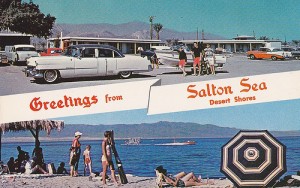I’ve been joking to my Colorado River management friends about how I keep trying to leave the Salton Sea out of my book. This effort has been such a failure that the Salton Sea now makes multiple appearances in the current draft. All paths to the end of my book’s argument seem to pass through the stinky, super-saline body of agricultural drainage water in southeastern California.
My latest effort to not write about the sea sent me back to reread a classic of planning literature, Horst Rittel and Melvin Webber’s 1973 “Dilemmas in a General Theory of Planning“. Rittel and Webber outline a general class of societal problems that are inherently difficult because they are, to use the authors’ lovely coinage, “wicked”. They don’t mean these problems are witch-like, but rather that they share these characteristics:
- there is no definitive formulation of a wicked problem – the possible solutions depend (strongly) on the problem definition, and the act of defining is a socially contested process
- wicked problems are never “solved” – in R and W’s language “they have no stopping rule”
Contrast this with what they call “tame” problems – ones for which we can clearly articulate the problem to be solved, and for which the definitions of success and failure are crisp.
My favorite example of a tame problem is the 1960s Apollo program to send astronauts to the moon. The problem to be solved was easy to describe: sending astronauts to the moon and safely returning them. Spaceship blows up on the way home? No question that’s failure.
Tame problems are not necessarily easy to carry out, they’re just easy to define.
Rittel and Webber were writing at a time when people were trying to apply the successes of science and engineering to social problems. We know how to build bridges that don’t fall down. Next up, poverty! But poverty turns out to be harder to define, and the solutions you pursue depend entirely on the definition you choose:
By now we are all beginning to realize that one of the most intractable problems is that of defining problems (of knowing what distinguishes an observed condition from a desired condition) and of locating problems (finding where in the complex causal networks the trouble really lies).
Which brings us to the Salton Sea, a problem located at the end of a really confusing causal network.
First formed in 1905 when the Colorado River breached Imperial Valley’s early irrigation works in a big way, the sea would have soon evaporated were it not for continued inflows of the valley’s irrigation drainage water. In fact, contrary to those who argue that “it was an accident, let it die”, it seems hydrologically likely that even without the accident of its original sin, the sea would exist today in sort sort of equilibrium after more than a century of ag runoff in the valley.
Its rise and fall has always posed problems – flooding of the farms around its shores drove major litigation in the 1980s over allegations that Imperial Irrigation District’s practices were causing the lake to rise because they were “wasteful”. The problem today is the opposite. Efforts to conserve water in Imperial today to permit ag-to-urban transfers in Southern California will slowly deprive the sea of inflows, causing it to shrink.
So what?
The “what” here is the wicked problem. Is it the loss of habitat for migrating birds? Is it the increasing air quality problems from the exposed shoreline? Is it the fading dream of a recreational paradise in the desert?
The real problem of the Salton Sea seems to have been that the people working on the problems of the Colorado River Basin were solving a different problem entirely – ensuring that water users from Denver and Grand Junction to Los Angeles and San Diego, with a lot of farms in between, had “enough” water. (How much is “enough”? Another wicked problem.) Down a tortured causal chain of water shortage (perceived or real) and water savings, you end up with less water flowing to a dying Salton Sea. One of Rittel and Webber’s key insights was that “every wicked problem can be considered to be a symptom of another problem.” Check that one off of your “wicked problems” bingo card.
I played at the top of this post with the Wicked Witch of the West as a rhetorical device, but in the end it doesn’t quite work. When the Great and Powerful Oz gave Dorothy and her traveling companions their assignment – “Bring me the broomstick of the Witch of the West” – it was pretty clear how success was defined. Tin Man: “B-B-B-But if we do that, we’ll have to kill her to get it!” Whatever. Just bring me the broom.
I’m still not sure I know how to define the problem of the Salton Sea quite so crisply.


